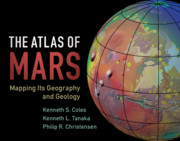Book contents
- The Atlas of Mars
- Additional material
- The Atlas of Mars
- Copyright page
- Table of Contents
- Preface
- Acknowledgments
- Abbreviations
- How to Use this Atlas
- Sources of Images
- Chapter 1 Introduction
- Chapter 2 History of Exploration of Mars
- Chapter 3 Global Character of Mars
- Chapter 4 Regional Geographic Features and Surface Views of Mars
- Chapter 5 Geology of Mars
- Map Sheets
- Mare Boreum (MC-1)
- Diacria (MC-2)
- Arcadia (MC-3)
- Mare Acidalium (MC-4)
- Ismenius Lacus (MC-5)
- Casius (MC-6)
- Cebrenia (MC-7)
- Amazonis (MC-8)
- Tharsis (MC-9)
- Lunae Palus (MC-10)
- Oxia Palus (MC-11)
- Arabia (MC-12)
- Syrtis Major (MC-13)
- Amenthes (MC-14)
- Elysium (MC-15)
- Memnonia (MC-16)
- Phoenicis Lacus (MC-17)
- Coprates (MC-18)
- Margaritifer Sinus (MC-19)
- Sinus Sabaeus (MC-20)
- Iapygia (MC-21)
- Mare Tyrrhenum (MC-22)
- Aeolis (MC-23)
- Phaethontis (MC-24)
- Thaumasia (MC-25)
- Argyre (MC-26)
- Noachis (MC-27)
- Hellas (MC-28)
- Eridania (MC-29)
- Mare Australe (MC-30)
- Moons: Phobos and Deimos
- Appendix
- Gazetteer
- References
- Index
Mare Boreum (MC-1)
from Map Sheets
Published online by Cambridge University Press: 16 August 2019
- The Atlas of Mars
- Additional material
- The Atlas of Mars
- Copyright page
- Table of Contents
- Preface
- Acknowledgments
- Abbreviations
- How to Use this Atlas
- Sources of Images
- Chapter 1 Introduction
- Chapter 2 History of Exploration of Mars
- Chapter 3 Global Character of Mars
- Chapter 4 Regional Geographic Features and Surface Views of Mars
- Chapter 5 Geology of Mars
- Map Sheets
- Mare Boreum (MC-1)
- Diacria (MC-2)
- Arcadia (MC-3)
- Mare Acidalium (MC-4)
- Ismenius Lacus (MC-5)
- Casius (MC-6)
- Cebrenia (MC-7)
- Amazonis (MC-8)
- Tharsis (MC-9)
- Lunae Palus (MC-10)
- Oxia Palus (MC-11)
- Arabia (MC-12)
- Syrtis Major (MC-13)
- Amenthes (MC-14)
- Elysium (MC-15)
- Memnonia (MC-16)
- Phoenicis Lacus (MC-17)
- Coprates (MC-18)
- Margaritifer Sinus (MC-19)
- Sinus Sabaeus (MC-20)
- Iapygia (MC-21)
- Mare Tyrrhenum (MC-22)
- Aeolis (MC-23)
- Phaethontis (MC-24)
- Thaumasia (MC-25)
- Argyre (MC-26)
- Noachis (MC-27)
- Hellas (MC-28)
- Eridania (MC-29)
- Mare Australe (MC-30)
- Moons: Phobos and Deimos
- Appendix
- Gazetteer
- References
- Index
Summary
The MC-1 quadrangle includes the north pole of Mars, which is covered by a 1,000-km-diameter plateau, Planum Boreum. This plateau rises 2–3 km above the surrounding northern lowland plains of Vastitas Borealis, which lie 3–5 km below datum. Planum Boreum is dissected by a large canyon, Chasma Boreale, which sets apart a secondary plateau, Gemina Lingula. These plateaus are dissected by the swirling, spiral troughs of Borealis and Gemini Scopuli. On the opposite side from Chasma Boreale, Olympia Planum forms a kidney-shaped rise that is partly buried by the Olympia Undae dune sea. These dunes also overlap the pancake-shaped rises of Scandia Tholi and the irregular depressions that form Scandia Cavi. The lowest parts of the northern plains occur around the tholi and at the mouth of Chasma Boreale. Dense fields of low knobs make up Scandia Colles. The Phoenix Lander site (see Chapters 4 and 5) lies in Vastitas Borealis.
- Type
- Chapter
- Information
- The Atlas of MarsMapping its Geography and Geology, pp. 64 - 71Publisher: Cambridge University PressPrint publication year: 2019

